Alecia Neo develops long-term projects that involve collaborative partnerships with individuals and communities. Her socially engaged practice unfolds primarily through photography, video, installations, and participatory workshops that address modes of radical hospitality, reciprocity, and caregiving to explore issues of identity and the search for self. Alecia is the co-founder of Brack, a platform for socially engaged artists in Southeast Asia, and recipient of the Young Artist Award (2016) presented by the National Arts Council, Singapore.
At the centre of this interview is Alecia’s recent work, ramah-tamah. Commissioned for the Singapore Heritage Festival (SHF) 2020, the piece centres the betel culture and traditions of betel chewing,a communal activity and tradition that has been observed in many parts of the Southeast Asian region and beyond. Alecia picked out some betel boxes and betel paraphernalia from the Asian Civilisations Museum, and these objects served as departure points both for ramah-tamah and this particular interview.
At the centre of this interview is Alecia’s recent work, ramah-tamah. Commissioned for the Singapore Heritage Festival (SHF) 2020, the piece centres the betel culture and traditions of betel chewing,a communal activity and tradition that has been observed in many parts of the Southeast Asian region and beyond. Alecia picked out some betel boxes and betel paraphernalia from the Asian Civilisations Museum, and these objects served as departure points both for ramah-tamah and this particular interview.

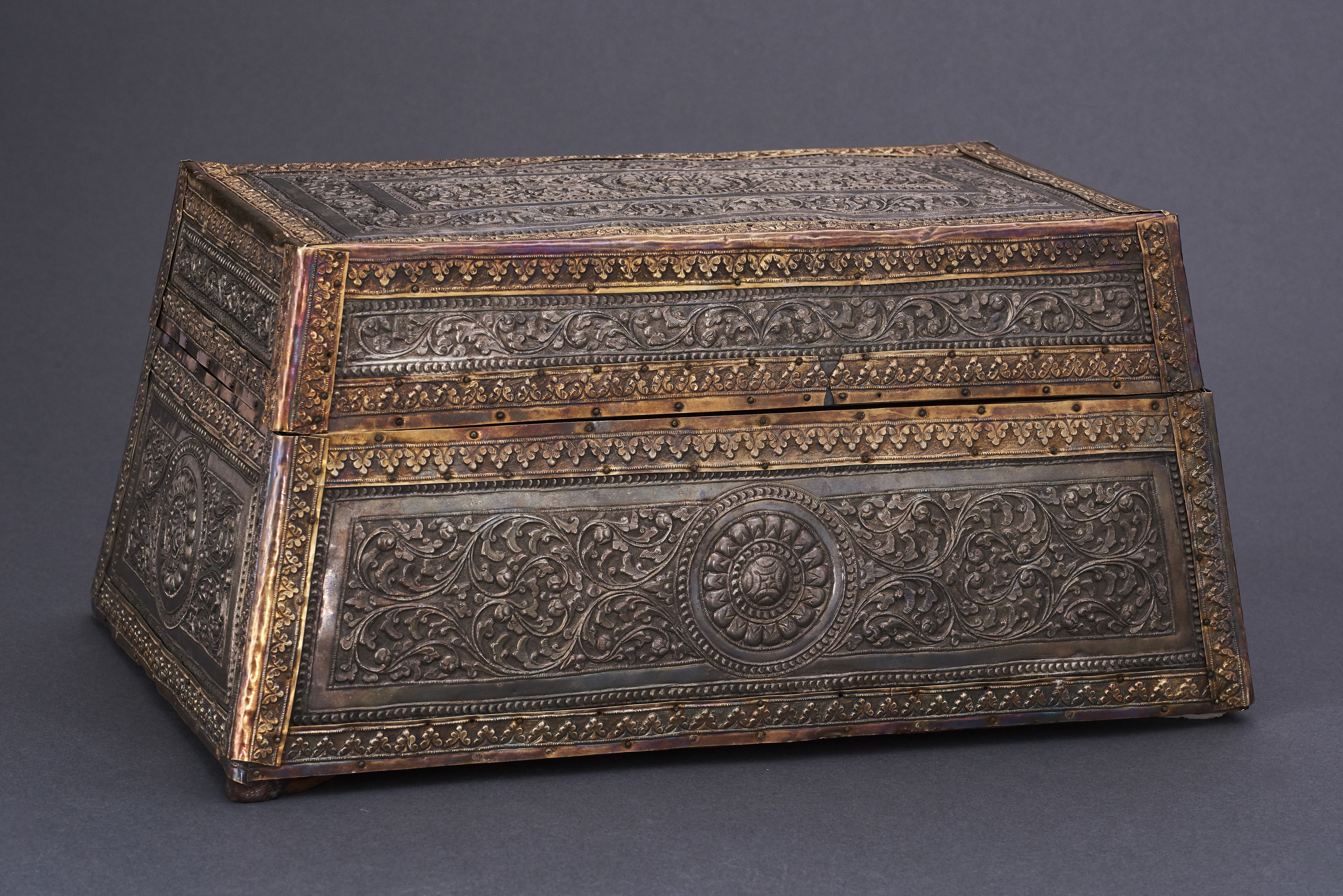
¹ Kotak sireh
19th century, Asian Civilisations Museum
Credit: Asian Civilisations Museum
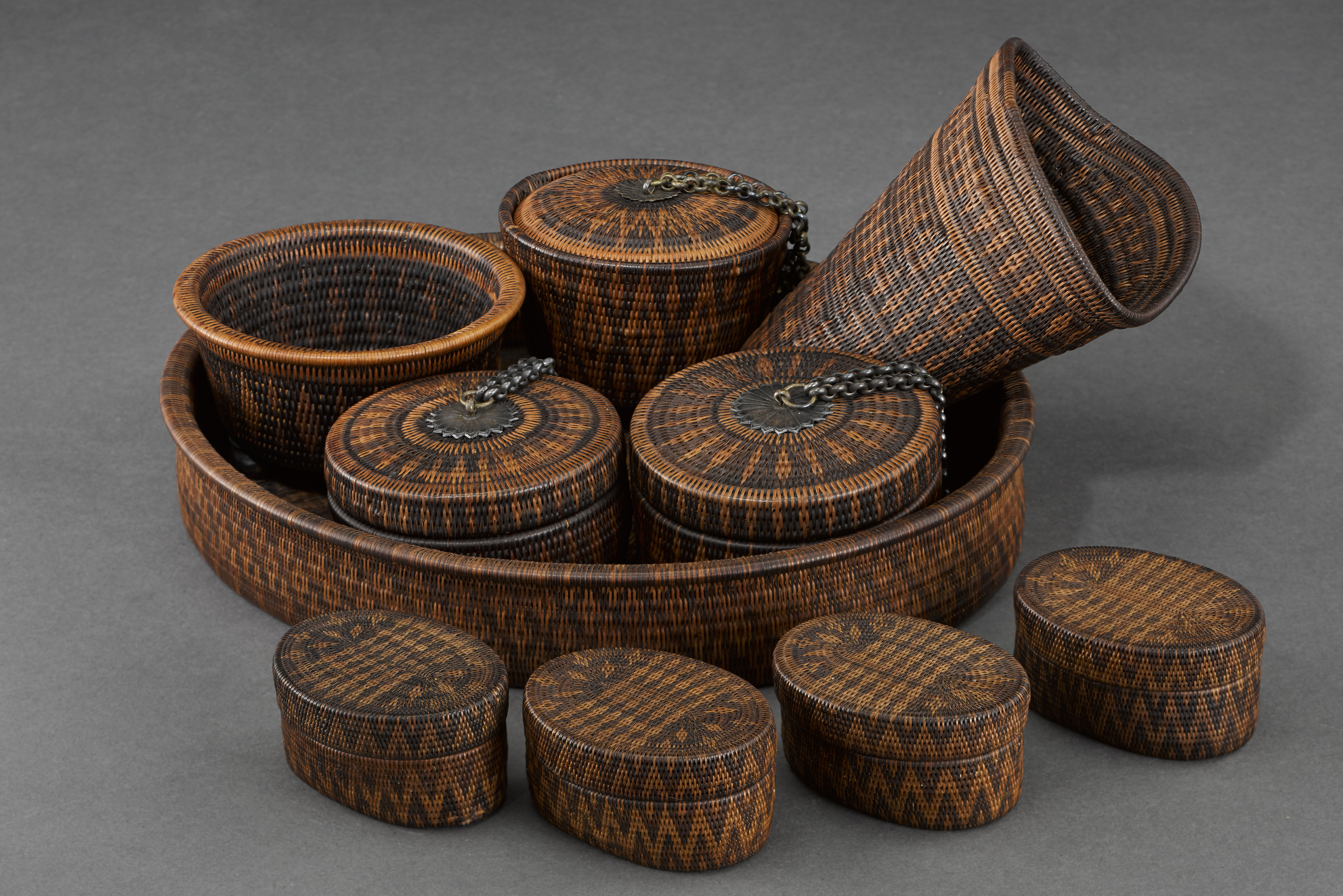
² Sireh set
c. 1910, Asian Civilisations Museum
Credit: Asian Civilisations Museum
For our conversation, you picked out a couple of betel boxes and paraphernalia. Before discussing these exquisite objects, let’s talk about the practice of betel chewing itself. Could you please tell us about what sparked off your interest in the practice of betel chewing?
To be honest, it has been a rather meandering journey. I didn’t have a relative or family member who chewed betel leaves. In fact when I first spoke to some of my older relatives about the practice, it triggered quite a visceral reaction. They recalled how certain neighbors would spit in public after chewing betel leaves, so the recent memory of the practice wasn't pleasant for them. During my artist residency at the NTU Centre for Contemporary Art Singapore (NTU CCA), I grew interested in the idea of hospitality. I was thinking about how traditional rituals and forms of hospitality could offer some insight into how we can build connections with others and foster a sense of community. Whilst looking quite broadly at what hospitality means within the context of Southeast Asia, my research process naturally came to food. From there, it was inevitable that I would discover betel culture. After a field trip to Bintan, my interest in betel culture deepened significantly. A group of young, female students did a demonstration of the makan sirih for me. The makan sirih is a welcome dance, which involves the offering of tepak sirih to guests. They schooled me in its significance and when its use would be appropriate. That was when I realised that, although betel culture has waned quite a bit in Singapore, it is still being actively performed and used all around the region — albeit in a more ceremonial capacity.
On the one hand, I was reading about the significance of betel in our culture. On the other hand, I had some people tell me about some of the unpleasant impressions and experiences they have with regard to betel chewing. I wanted to deepen my understanding around this contradiction. As I continued with my research, I came to realise that there is an incredible amount of symbolism attached to betel chewing and betel culture. Yet, it has largely disappeared from Singapore’s cultural memory. If you ask most people, they will probably have vague memories of their grandparents chewing betel leaves. Some might recall owning a sireh set as well. This is a culture that has been practiced locally and regionally for more than two thousand years, but it’s mostly forgotten today. I wanted to figure out what these gaps in our knowledge were. Some have speculated that betel culture was affected by a combination of factors, including the arrival of European missionaries in Singapore and strict government policies against spitting. As smoking became more mainstream, some believe it probably also replaced the practice of betel chewing. Having said that, betel culture goes beyond being symbolic on a social level. It is used as food, medicine and also in the spiritual context. It is associated with major life events such as marriages and rites of passage. I was really curious as to if and how these practices have continued.
³ ramah-tamah, Alecia Neo
2020, Video Still
Credit: Alecia Neo
⁴ ramah-tamah, Alecia Neo
2020, Video Still
Credit: Alecia Neo
2020, Video Still
Credit: Alecia Neo
⁴ ramah-tamah, Alecia Neo
2020, Video Still
Credit: Alecia Neo
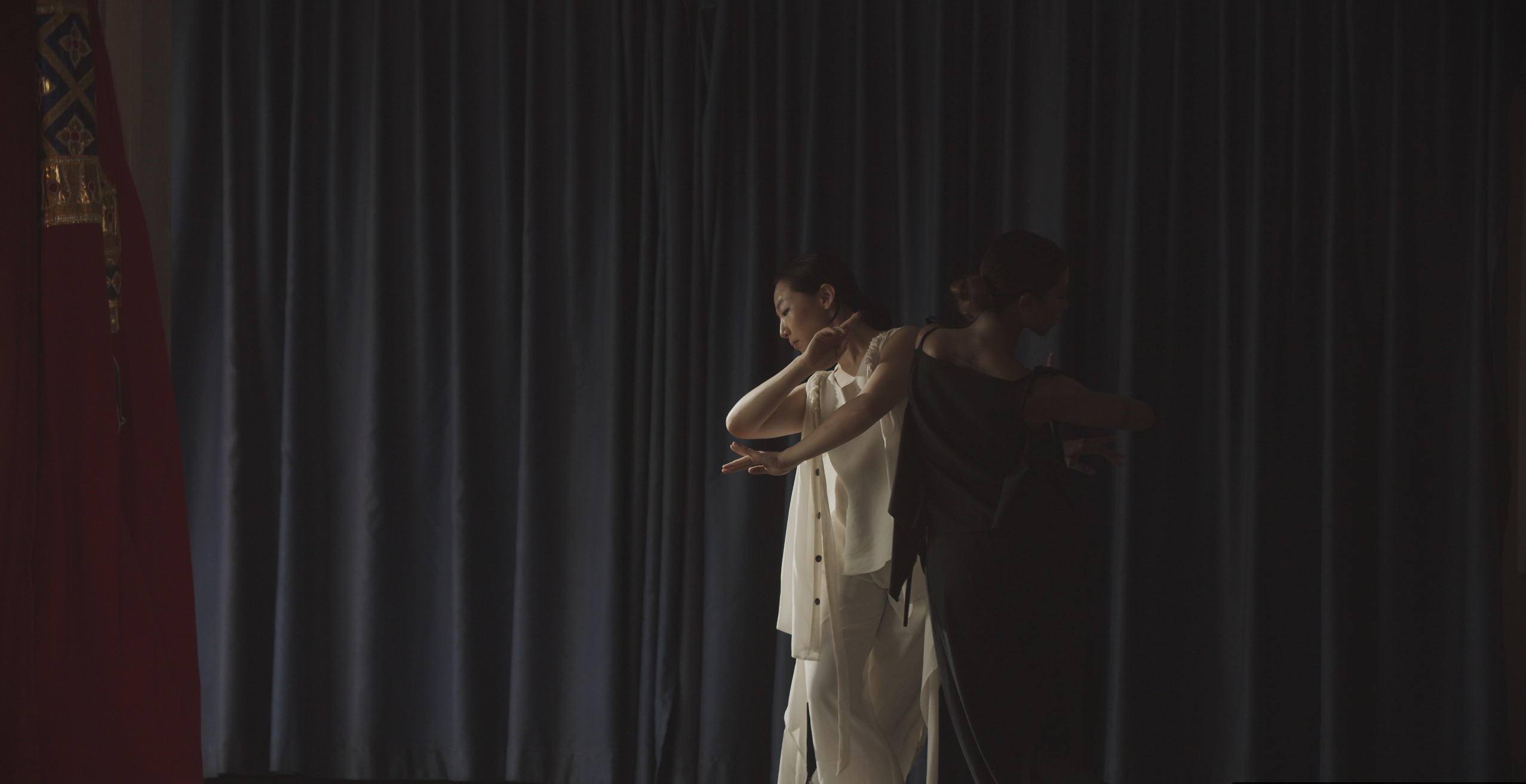

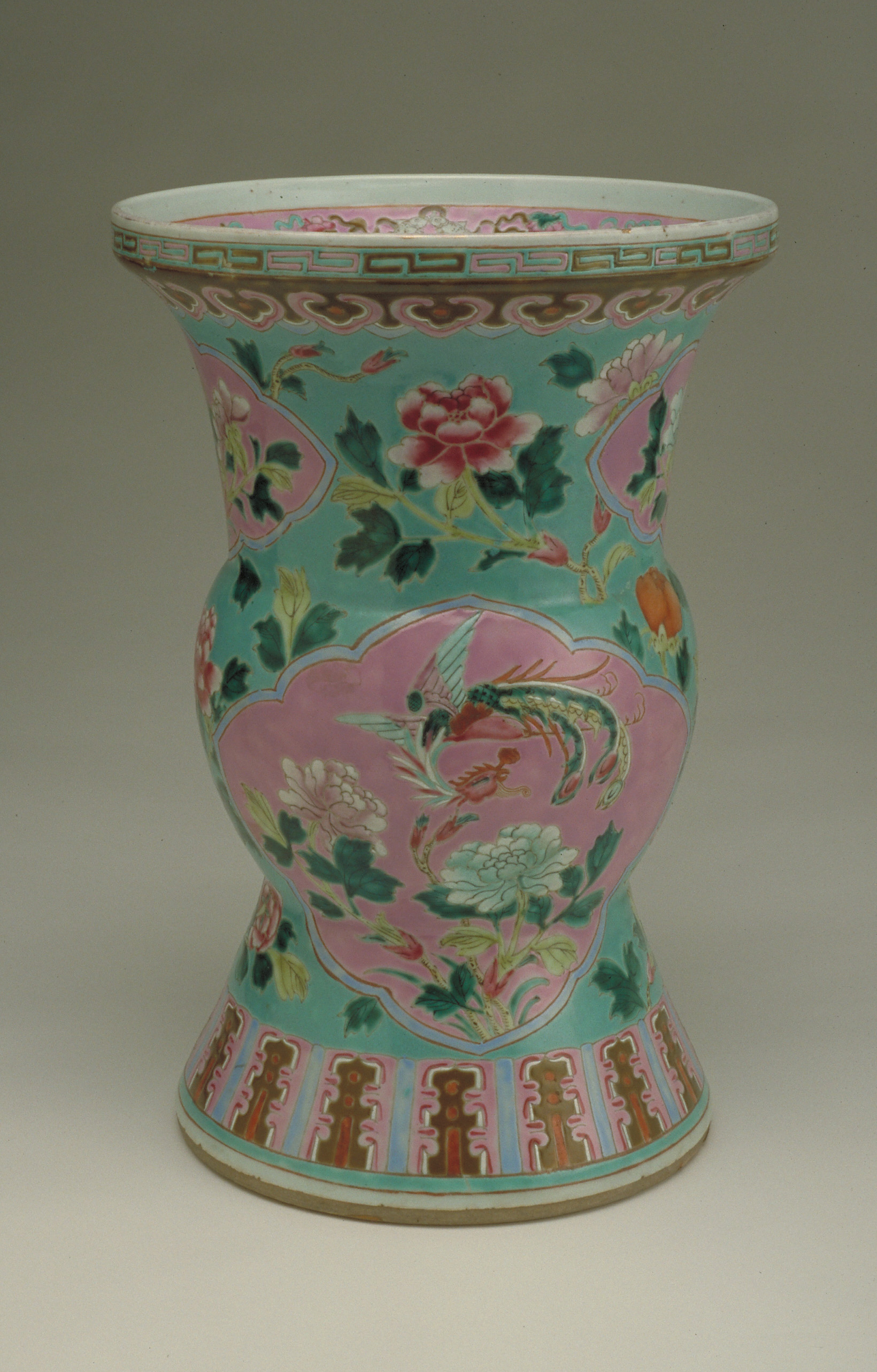
⁵ Spitoon
Late 19th-early 20th centuries, Asian Civilisations Museum
Credit: Asian Civilisations Museum
As you mentioned, these betel boxes and objects have been an important fixture within traditional cultures and they were often brought to life through various hospitality ceremonies. Today, most of us will have our first encounter with these artefacts in the context of museums or cultural institutions — with these objects often sitting behind secure glass boxes. Turning now to the objects that you’ve picked out, could you tell us about how you put together this selection of objects?
When it comes to the object, what I find fascinating is how the betel set functions as a tool for communication. If you are not offered betel upon arrival into someone’s home, the message sent is that you are not welcome. Without saying a single word, one’s intentions can still be communicated clearly. For this interview, I selected a couple of betel boxes and all of them vary in terms of style. I chose them because of their diversity, really. There are so many different materials and designs when it comes to betel boxes and betel paraphernalia, and these variations often offer insight into where these objects were made. For example, betel boxes made in Burma look very different to those made in Malaysia. I came across a couple of Burmese betel boxes at the Asian Civilisations Museum, which were cylindrical in form and coloured red from pigments found in the local area. In Singapore and Malaysia, betel boxes are often made of metal or wood. In short, these objects and their designs are informed by their geographical contexts, cultural practices and religion. I’m interested in how we embed our social identity into these cultural objects.
Another point that I found incredibly fascinating was that the use of sireh sets and betel boxes would cut across all social classes. On the one hand, there are these incredibly ornate betel boxes made with precious metals and materials that have been made for royalty. In certain royal courts, there were servants whose specific role was to care for these ornate objects and carry out these rituals of hospitality. On the other hand, you have betel boxes owned by humble, everyday people. These would often be simple, undecorated objects that were made of materials such as wood, and functional. One of my interviewees for ramah-tamah was the artist Vimal Kumar. He remembered how his grandmother would chew in the privacy of her own room. He noticed that she would store her carefully cleaned betel leaves in a plastic Tupperware container and use a Milo tin can as her spitoon.
These objects and their designs are informed by their geographical contexts, cultural practices and religion. I’m interested in how we embed our social identity into these cultural objects.
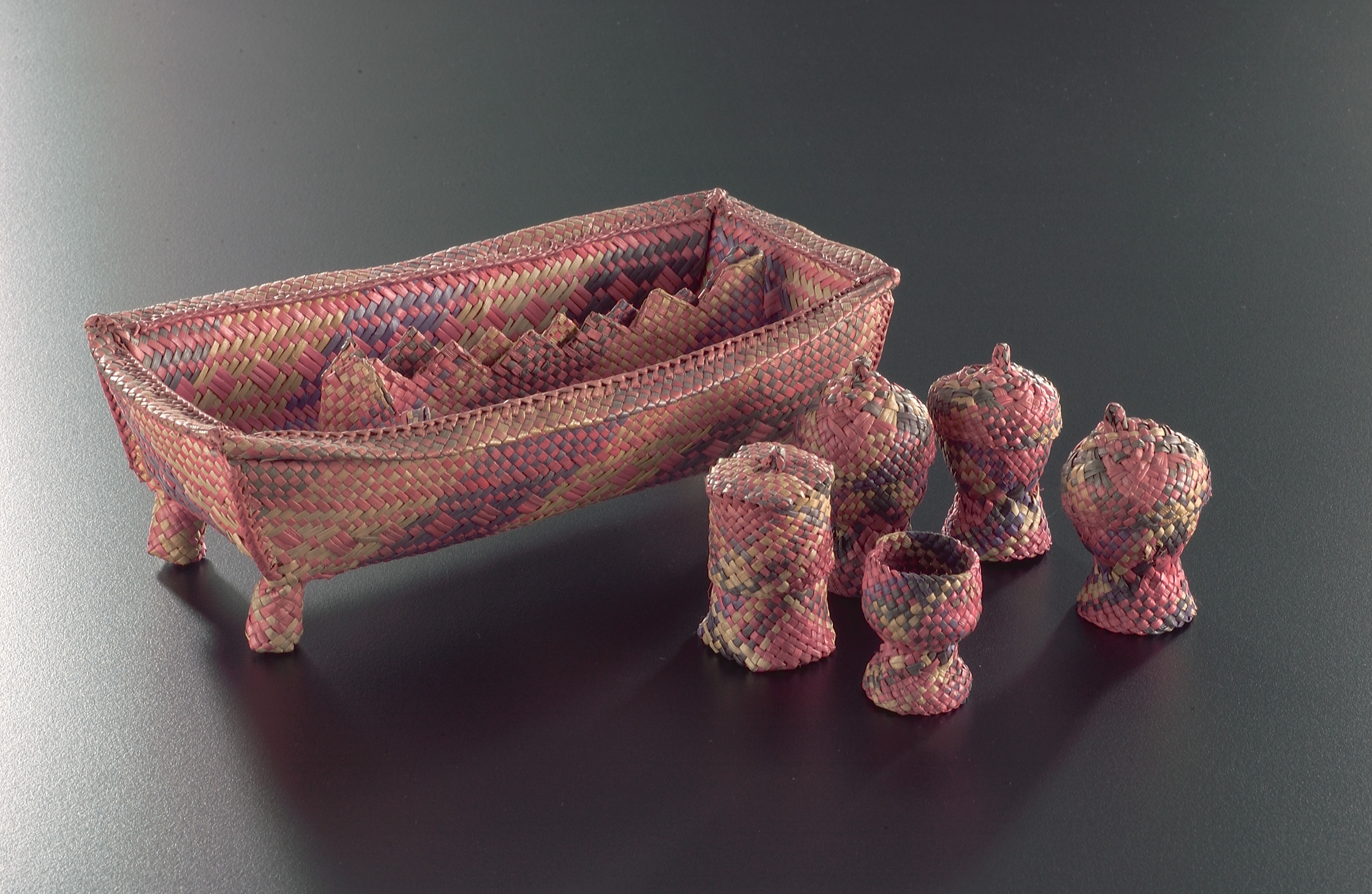
⁶ Sireh set
Mid 20th-century, Asian Civilisations Museum
Credit: Asian Civilisations Museum

⁷ Sireh set
Asian Civilisations Museum
Credit: Asian Civilisations Museum
How did you draw upon these betel paraphernalia in the process of conceptualising ramah-tamah? Were they anchoring points of reference, generative sites of imagination, or something else?
The objects definitely functioned as a springboard to a lot of different ideas. In particular, I was interested in how women navigated the expectations placed on them by tradition and culture. When I look at traditions, and even in this case where I’m extremely fascinated by them, I can also see how it could have cut both ways. The work was really about this ambivalence when it comes to thinking about tradition. As part of my research process, I spoke to people who were familiar with betel culture. For a lot of the interviews I conducted, I noticed that the women, and the men who shared stories about women, expressed this ambivalence as well.When I look at these beautiful objects, I am very much reminded of the role they played in a particular time. This is why the work, ramah-tamah, ends with a question. Where do we go from here? In the present day, with our current concerns and conflicts, where does this tradition actually sit? What does it do for us now? Do we need to reinvent new traditions, and can we look to the past for inspiration? With this work, I’m interested in igniting conversations around where these traditions can be taken, and how we can make it our own.
Earlier in our conversation, we spoke about the symbolism embedded into these objects. At a wedding ceremony, for example, the way the betel box is placed would tell of a bride’s purity. These objects could be read in so many different ways, and I spent a lot of time thinking about how women would have navigated these situations. These stories were passed down to them from their mothers. How would they then pass these stories onto their own children? That’s why I eventually settled on a narrative for ramah-tamah that imagines this dialogue between a mother and daughter.
⁸ ramah-tamah, Alecia Neo
2020, Video Still
Credit: Alecia Neo
⁹ ramah-tamah, Alecia Neo
2020, Video Still
Credit: Alecia Neo
2020, Video Still
Credit: Alecia Neo
⁹ ramah-tamah, Alecia Neo
2020, Video Still
Credit: Alecia Neo
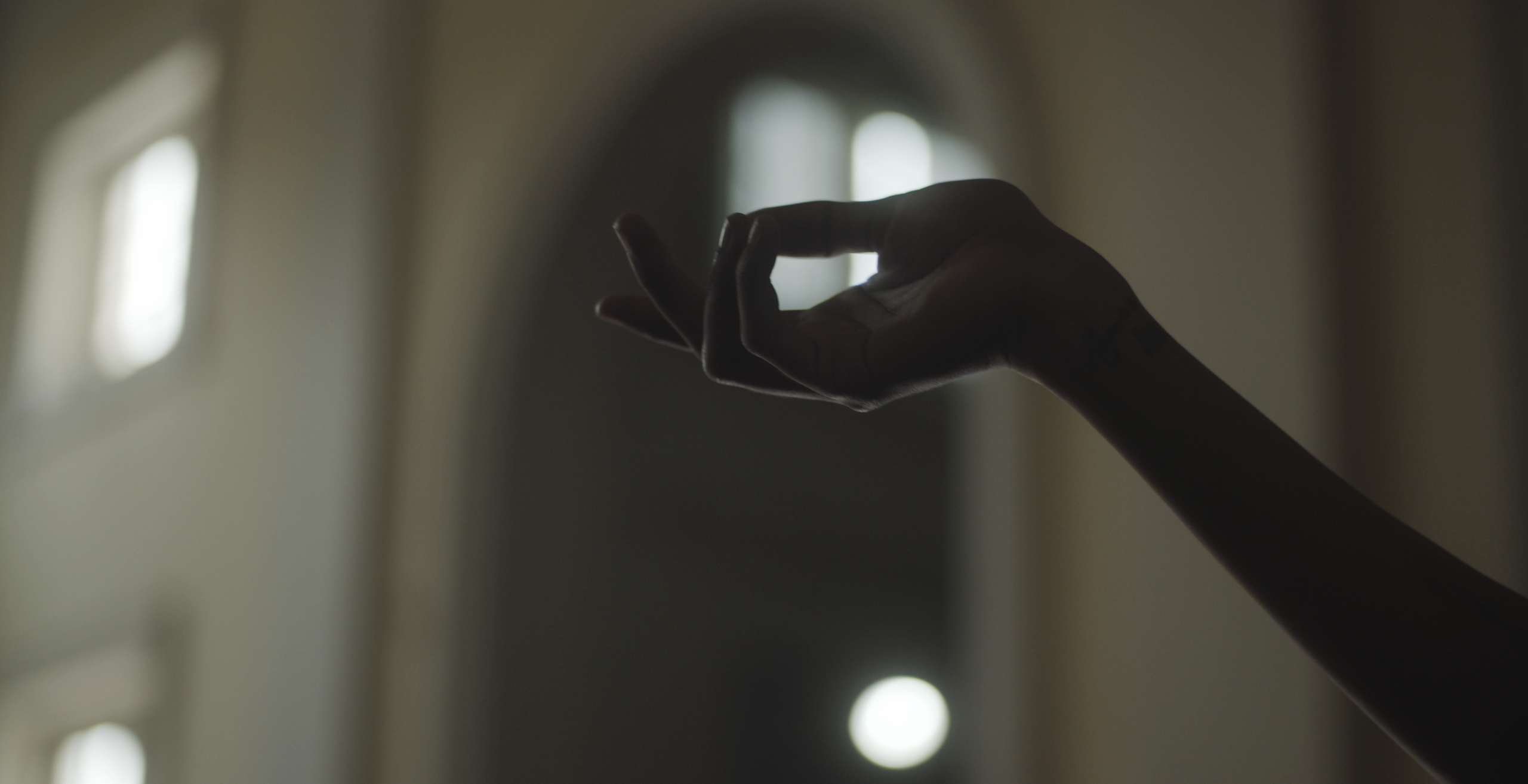
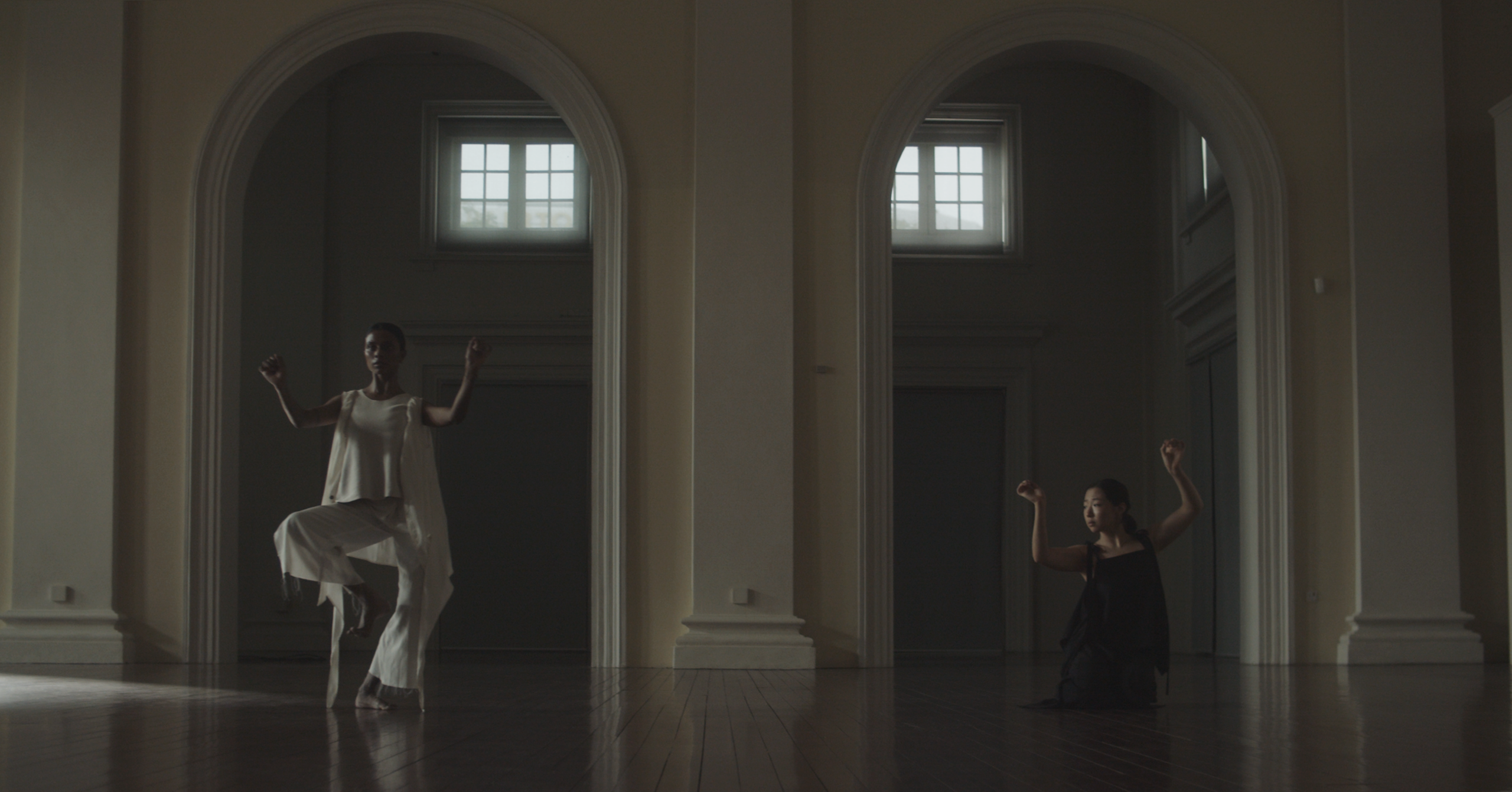
The work is slow at times, and the tempo picks up at others — with a main text or voiceover as narrated by yourself interspersed with pantuns recited by Baba GT Lye. Tell us about the importance of pacing within the work, and how you approached the collaborative process of pouring the rhythms of the text and pantuns into movement.
The nature of this work is collaborative, and I see it as a dance between all the collaborators involved. A good example of how this dance played out would be the texts that were exchanged between Baba GT Lye and myself. I wrote a draft script, and in this initial version, I had no intention of using pantuns. When I interviewed Baba for his knowledge of sireh, I found out that he was a master of dondang sayang and pantuns. As I shared my working script with Baba, he spontaneously composed some pantuns on sireh and its associated traditions. The first four pantuns read in ramah-tamah reference the use of sireh in everyday life. One of the pantuns speaks of a mak andam. The mak andam can be described as a makeup artist, but in the past, they used to play a spiritual role as well. The mak andam could chew on the betel quid and it was said that their incantations were magical. They could make one look beautiful, and it wasn’t just about this radiance as well. It was also about protection, and these incantations warded off evil for the brides. All the pantuns composed for the work speak of a reverence for the betel set and the potency of its symbolism.After I incorporated these four pantuns into the work, I showed them to Baba again. At that point, he revealed to me that he had actually composed a fifth pantun at our last meeting. Sometimes as an artist, there is this natural desire to keep some things for yourself. Yet after seeing the work, he felt that the fifth and final pantun would be incredibly apt for the closing of my work, and he generously shared it with me. The final two lines of the fifth pantun reads:
Tolay ke-kiri di-kekana pun tidak
Knowing nobody on one's left or right
Itu lah nasib dagang piatu.
Such is the fate of the orphan traveler.
Knowing nobody on one's left or right
Itu lah nasib dagang piatu.
Such is the fate of the orphan traveler.
It really described what I was exploring in the last section of the work, which is about aging. It is about that process of a younger generation learning to stand on their own feet, especially as they discover that the people and the women who have been nurturing them, are fading away. What are their roles now, and what are the positions they have to embrace?
There was also this rather spontaneous rhythm that was established by the main text. When I took the initial text to the performers, Sandhya Suresh and Kyongsu Kathy Han, it was really interesting to see how they first responded to it. We all work in similar ways in that we enjoy working with images. When we analysed the text, we shared the pictures that were forming in our minds. We were asking ourselves questions about the quality of the relationship between the two characters, how their narratives were intertwined. Which images were the strongest in our minds, and how did we want to play around with them? When we eventually went into the physical space to rehearse and film, it was extremely improvisational. We were making this work throughout the Circuit Breaker or lockdown period in Singapore, and it was rather difficult to work through the digital interface. Translating our discussions into the physical realm meant that we all had to think on our feet.
Some of the most interesting work, however, came in its post-production. When the composer and sonic artist Li-Chuan Chong received the video, he was also trying to determine what the pulse of the piece would be. He sent me a screen capture of an initial draft he put together, highlighting the tempo of the piece. He determined this at 82 beats per minute, which lies slightly above the resting heart rate of a person. It lends this sense of unpredictability and uncertainty to the piece, and it speaks to the improvisational nature of the work. Ultimately, I think that the rhythm of the piece was really informed by our individual practices, and the way we responded to one another’s energies.
I wanted to take some time to speak to the dance forms within ramah tamah as well. They both took inspiration from the references that I shared, but they also brought in a lot of their own training in traditional dance forms, such as Odissi, into the work. All of this lent weight to their performance.
¹⁰ ramah-tamah, Alecia Neo
2020
Credit: Alecia Neo
2020
Credit: Alecia Neo
Could you tell us more about the specific betel box that was featured within ramah-tamah?
The betel box we used in the performance was a gift to the work, you could say, from Baba. The box is almost a hundred years old, and it was gifted to Baba by a friend of his. It was her wedding betel box, and his friend entrusted him with caring for the box because she felt that her children would probably discard it. This particular box had been passed through the generations. It was on her mother’s wedding bed, and she later used it for her own wedding as well. These personal objects have had huge significance for people, and I do think that this worry of being erased from memory or no longer having that continuity is very real. When I interviewed families about betel culture, they would always have these vague memories of their relatives chewing betel leaves. When asked about the fate of those betel objects, more often than not, they would have been discarded awhile ago.
Baba gave me very strict instructions with regard to the handling of the box. It was always to be placed respectfully, ideally on a tabletop. He also stressed that this wasn’t an object that one could play around with. It has to be revered, and this is something that’s emphasised in the pantuns he composed. For me, the work was also an invitation for people to reimagine what the role of these objects could be, and what some of the gaps in our current contemporary knowledge are.
The work was also an invitation for people to reimagine what the role of these objects could be, and what some of the gaps in our current contemporary knowledge are.
The tradition of betel leaf chewing is a deeply symbolic and important one. Centered around hospitality and often performed by women, it draws an inextricable relationship between the two. Tell us about some of the considerations you had in extending these histories into the present day, and how it was like to create that shared space between the work, the performers and the viewer — even as the work became mediated through the digital screen.
When I was first approached to make this work, it was conceived as a physical installation. The entire COVID-19 situation really dismantled this premise quite quickly, and I had to think quite carefully about whether the ideas I had could be translated into a single channel work. It was a huge gamble, and we had to be experimental. I wanted the format and the outcome of the work to reveal the conditions that we were working in.
The work is described as a prelude because I see it as a sketch of this exact moment in time. In an odd way, I suppose a lot of ideas of hospitality were lived out through the production of this work as well. How could the process of filming be made hospitable, for example, given all the precautionary measures that we had to take? In time, I would love to revisit the work in a physical format, and to further unpack some of the initial ideas. It would probably emerge as quite a different work.
When I was first approached to make this work, it was conceived as a physical installation. The entire COVID-19 situation really dismantled this premise quite quickly, and I had to think quite carefully about whether the ideas I had could be translated into a single channel work. It was a huge gamble, and we had to be experimental. I wanted the format and the outcome of the work to reveal the conditions that we were working in.
The work is described as a prelude because I see it as a sketch of this exact moment in time. In an odd way, I suppose a lot of ideas of hospitality were lived out through the production of this work as well. How could the process of filming be made hospitable, for example, given all the precautionary measures that we had to take? In time, I would love to revisit the work in a physical format, and to further unpack some of the initial ideas. It would probably emerge as quite a different work.
On that note with regard to storytelling, this work was the result of a considerable amount of time and research. Earlier, you mentioned how this process was a meandering journey. Could you tell us a little more about this research process, and how your travels and the stories that were shared helped to clarify the sort of ideas you had for ramah-tamah?
My research process for this work, and for all of my other works, always starts with the stories of people. That is a starting point and it is also what gives me a roadmap. In ramah-tamah, the text is divided into three chapters. It begins with the coming of age, moves into adulthood and the process of caregiving, before finally arriving at ideas of aging, death and rebirth. These ideas were inspired by the stories collected from interviews I conducted or historical accounts. I felt very privileged to have had that time with these people, and to have experienced their generosity in how they shared their lived experiences.
They shared beautiful stories of migration with me, speaking of how people embraced intercultural identities. Some of the most interesting stories I heard were of marriages between two people from different cultures. The bride would be introduced to these traditions and cultures through their marriages, and there was this weight of trying to, firstly, recognise their own positions and ambivalence towards these traditions, and secondly, grapple with questions of how these traditions could then be passed on to their children. I also learnt a lot about betel chewing within Peranakan Chinese families from these interviews. Throughout the Southeast Asian region, betel chewing is often practiced by both men and women. However within the context of Peranakan Chinese culture, betel chewing became something that only women do. In fact, if men were to chew betel leaves, it would have been considered rather effeminate. I was also deeply moved by memories of women who quietly and privately chewed betel as a source of comfort and strength in their older years. Although betel chewing is commonly associated with a social dimension, these stories were about pleasure and reclaiming space for themselves, in spite of the pains of aging. These stories helped me to plot the structure of the work.
The work is personal that way. I’m interested in how people navigate the conditions that they are placed into. To what extent do we have control over our circumstances, and what sort of decisions can we make for ourselves?
I was also deeply moved by memories of women who quietly and privately chewed betel as a source of comfort and strength in their older years. Although betel chewing is commonly associated with a social dimension, these stories were about pleasure and reclaiming space for themselves, in spite of the pains of aging.
¹¹ Between Earth and Sky, Alecia Neo
2018, Video Still
Credit: Alecia Neo
¹² Between Earth and Sky, Alecia Neo
2018, Video Still
Credit: Alecia Neo
2018, Video Still
Credit: Alecia Neo
¹² Between Earth and Sky, Alecia Neo
2018, Video Still
Credit: Alecia Neo


Caregiving is something that you've explored not just with ramah-tamah, but with works such as Between Earth and Sky as well. Providing physical or emotional care for another is a concept that many have a broad (albeit limited) understanding of. In your experience, how has art served as a productive means for going deeper into this idea, particularly when it comes to experiences that are difficult to verbalise or enunciate?
Exploring caregiving through artistic means has been an incredibly rich experience for me because sometimes, words are not enough. The act of giving care, receiving care, and even rejecting care — these are all actions that are embodied. For people who have experienced being caregivers, in any capacity at all, most of them would say that articulating the experience verbally is difficult, and words are insufficient. This is why I’ve experimented with visualising the weight of caregiving in some of my past works. A really potent way of doing this is through movement.
I used to participate in a support group for caregivers, and there was a sense of solidarity between the caregivers. This solidarity was formed through the act of listening to one another’s stories and being heard by others. This was something the work Between Earth and Sky attempted to offer in some ways. Even if one was practicing alone in private, making their own performance, or dance, they were doing it for themselves, but in that doing, you are also connected to others. Within the artistic process, that has been an incredibly precious thing for me. Art offers us a chance for introspection, and to hold a mirror to one’s own experiences. And when you’re ready, you can then show it to others.
Between Earth and Sky was made in collaboration with Sharda Harrison and Sharda’s mother, Ajuntha Anwari. As a mother and daughter pair, they both brought something very special and personal to the work. The project involved collaborations with people who were the primary caregivers for a family member. It made me think about creating an index of care, with the hope that some of these gestures could be archived, repeated and shared. Perhaps in the process, these sensations and insights can be transferred to others. This was what we were trying to experiment with through the project, and I do hope that the work can be developed further.
Some of the ideas explored in Between Earth and Sky certainly went into the making of ramah-tamah. I’ve been asked why I decided to employ movement with ramah-tamah. There’s such a strong connection between betel culture and dance, so using movement to communicate these ideas felt incredibly apt. During my research process, I had the opportunity to speak with Marina Yussof, who is the creative director at Sri Warisan. She offered some insights into gestures associated with betel and hosting, such as the sirih pinang, where you gracefully prepare and present the betel quid to express a special intention.
¹³ Between Earth and Sky, Alecia Neo
2018, Trailer
Credit: Alecia Neo
2018, Trailer
Credit: Alecia Neo
Your practice is incredibly multi-faceted, but something that you’ve always been laser-focused on community development and giving back. Having established an extensive practice based on these ideas, what do you think it is about art that makes it such an emotive and generative catalyst and tool for social change?
In my practice, I tend to gravitate towards a flow within any given context. With some of my other on-going projects, such as Brack, they have manifested themselves as networks or platforms for collaborations over time. Some of the projects I work on grow and develop along their own paths, and it’s often difficult to say that they’ve been precisely directed towards a particular goal, orientation or form. The porous nature of these projects allow collaborators from different backgrounds or with varying practices to come in and shape how it grows.
Art making offers a rare chance to suspend our disbelief or the need for transactional, quantifiable expectations. It has a capacity for open-endedness, which allows for experimentation, and that’s why I keep coming back to it. When it comes to thinking about an artist’s work, and why it is the way it is, perhaps it points towards something the artist is looking for. Generosity is something that I value deeply, and maybe art making can be seen as a way of creating fantasies as well — dreaming up the life we’d like to have and the communities we’d like to see.
In my practice, I tend to gravitate towards a flow within any given context. With some of my other on-going projects, such as Brack, they have manifested themselves as networks or platforms for collaborations over time. Some of the projects I work on grow and develop along their own paths, and it’s often difficult to say that they’ve been precisely directed towards a particular goal, orientation or form. The porous nature of these projects allow collaborators from different backgrounds or with varying practices to come in and shape how it grows.
Art making offers a rare chance to suspend our disbelief or the need for transactional, quantifiable expectations. It has a capacity for open-endedness, which allows for experimentation, and that’s why I keep coming back to it. When it comes to thinking about an artist’s work, and why it is the way it is, perhaps it points towards something the artist is looking for. Generosity is something that I value deeply, and maybe art making can be seen as a way of creating fantasies as well — dreaming up the life we’d like to have and the communities we’d like to see.
Art making offers a rare chance to suspend our disbelief or the need for transactional, quantifiable expectations.
